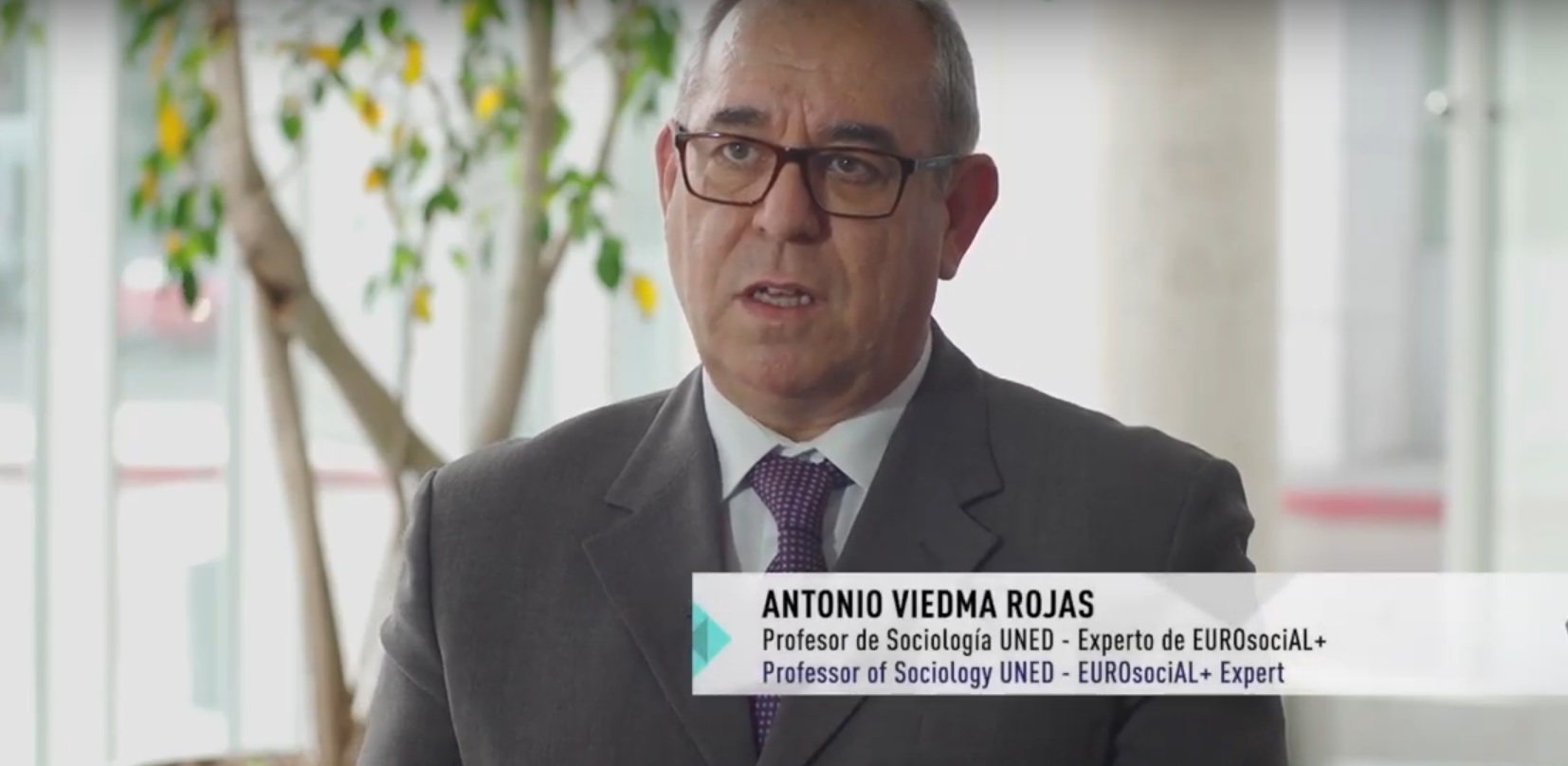By Antonio Viedma Rojas, EUROsociAL+ expert: Doctor of Sociology, Professor at the UNED Department of Sociology I (SPAIN)

The Montevideo Declaration
In September 2019, the collaboration between three European Union regional programmes, EUROsociAL+, EL PAcCTO and COPOLAD-II led to the holding in Montevideo of a bi-regional conference between Europe and Latin America and the Caribbean, with the aim of spreading the use of alternative measures to prison as a form of penal enforcement. The result of the conference was enshrined in the Montevideo Declaration. The document included three key issues: a diagnosis of the critical situation that many prison systems are experiencing; justification for the need to use alternative measures to prison in penal enforcement; and the commitment by participants to spread the use of alternative measures in their countries. The regional diagnosis showed a very complex reality: overcrowding, unhealthy living conditions, insecurity and the inability of systems to facilitate effective social inclusion for people deprived of liberty.
In this scenario, the appearance of the COVID-19 pandemic supposes yet another upheaval. The high risk of spreading the disease is unquestionable in prisons with high population densities, where it is practically impossible to maintain social distancing. It is widely recognized that living conditions in most prisons are not adequate to contain the disease. It is foreseeable that if transmission is not controlled, the effects may be devastating. The news coming from countries in the region is alarming, the disease is spreading in jails in several countries.
Points of view within International Organisations
The diagnosis by international health and human rights organisations[1], including the WHO, OHCHR, IACHR[2], indicate that the overcrowding and the weak prison and public health systems in the countries most exposed to the pandemic may cause a tragedy of great proportions. Their recommendations clearly demonstrate the need to carry out processes of urgent release through the use of alternative measures, both as a way of safeguarding the security of the most vulnerable groups and to reduce overcrowding to guarantee social distancing.
The definition of vulnerable groups presented by these organisations is based exclusively on health risk criteria. This group includes the elderly, the disabled, those suffering from certain diseases, pregnant women or those with children in prison, etc. For the rest of those who could be released, governments are called upon to implement the conditions proposed by international agreements on alternative measures to prison[3].
The nature of these organisations means that their proposal is limited to the health and criminal sphere, but there is a third way: alternative measures were conceived to facilitate the social inclusion of people who break the law and this perspective must be considered.
The situation of women in the face of COVID-19
During the Bi-regional Montevideo Conference discussions were held on the Document on the Gender Perspective and Alternatives to Prison Sentences.Strategies to Improve Inclusion Processes and the Abandonment of Crime in Women, in which the inclusion of this third way was proposed as a strategy to develop a gender perspective in the use of alternative measures. Women make up the biggest minority which is most discriminated against by the prison system, where their situation of social vulnerability is extreme. They are the best example when putting forward the case that factors of health risk and criminal situation cannot make up the only elements in a judgement. Let’s see what has happened in the case of COVID-19.
In general, the only women who have been included in the enacted legislation related to the pandemic have been those considered as being in vulnerable groups, specifically: pregnant women or those living with young children in prison and older women. This standard has been extended to many countries, among others: Chile, Argentina, Brazil, Costa Rica, Colombia, etc. However, the application of such releases is not usually exclusively based on medical criteria. Usually these releases are linked to an alternative measure (electronic surveillance or confinement at home) which, in addition, usually requires compliance with certain conditions regarding the length of sentence served and the time remaining to be served. In other words, release is a controlled change in the conditions of execution of the sentence.
That said, although these releases are welcome, it is clear that there are important issues that seem to be neglected. The first is that all the decisions are limited to women who have been convicted because they are linked to the length of sentence completed and the time to be served, but what happens to women who are awaiting trial? In many countries, such cases make up a very high percentage and all of them will be left out of consideration.
Likewise, we know that sentences for retail drug trafficking and petty theft have been increasing in all the countries of the region. Sentences are very long and it is certain that the time limitations that many countries have imposed will leave out a large population of women. Consequently, it is possible that many of those who should be integrated into these risk groups are themselves risking their lives because of the sentences imposed on them.
Furthermore, motherhood is limited to those children living with them in prison or to those who are less than three years old. Most women who get sent to prison in the region have under age children that they have left with their grandmothers or acquaintances. In addition it is recognized that men very rarely take on the role of caregiver and also that most of these women maintain the role of female heads of household even when they are in prison. They continue to maintain the family subsistence economy. Therefore, circumscribing the age of children to define dependency does not seem to be a wise decision. The definition of “dependent children” cannot be limited to those who live with them in prison. They have under age children who, in a situation like the one caused by the pandemic, are placed in a situation of extreme vulnerability.
It should not be forgotten either that many of them have been victims of gender violence and that the situation of their children is very delicate. In the conditions of isolation and dependency caused by the pandemic, violence and abuse is increasing alarmingly. It would be much safer for these children to be in the care of their mothers and for them to be serving their sentences with an alternative community measure that would protect them all from any such abuser.
It is logical to think that for prison officials or prison supervision court judges who decide to release them during this pandemic, it is better to have simple criteria which are easier to gauge, and it is clear that this is more easily provided for by a medical certificate or a review of the length of sentence and the time that remains to be served. It is also clear that this decision is easier to justify in a society reluctant to give second chances. However, even though they are more complex to apply, criteria related to real possibilities of social inclusion, intervention that facilitates possible social and employment reintegration, conditions of social vulnerability or community support can be key elements in the improvement of such a decision. The fairest, and perhaps most risky, approach is to dare to offer an alternative measure to save the lives of many women (and men) who live in a punitive social context and are imprisoned for minor and non-violent crimes. Let us hope that there are many people who are responsible for such decisions, people who dare to avoid tragedy.
By Antonio Viedma Rojas, EUROsociAL+ expert: Doctor of Sociology, Professor in the UNED Department of Sociology I (SPAIN).
[1] The World Health Organization and the Office of the High Commissioner for Human Rights issued specific recommendations in March to address the pandemic from a human rights perspective. https://www.ohchr.org/SP/NewsEvents/Pages/COVID19Guidance.aspx
[2] Resolution Nº1/2020 of 10 April, Pandemic and Human Rights in the Americas from the Inter-American Commission on Human Rights (IACHR), https://www.oas.org/es/cidh/decisiones/pdf/Resolucion-1-20 -en.pdf
[3] The Tokyo Rules. On the use of alternative measures to prison. https://www.un.org/ruleoflaw/files/UNITED~2.PDF
United Nations Rules for the Treatment of Prisoners and Non-custodial Measures for Female Offenders (Bangkok Rules): https://www.unodc.org/documents/justice-and-prison-reform/crimeprevention/65_229_Spanish.pdf
[1] The World Health Organization and the Office of the High Commissioner for Human Rights issued specific recommendations in March to address the pandemic from a human rights perspective. https://www.ohchr.org/SP/NewsEvents/Pages/COVID19Guidance.aspx
[2] Resolution Nº1/2020 of 10 April, Pandemic and Human Rights in the Americas from the Inter-American Commission on Human Rights (IACHR), https://www.oas.org/es/cidh/decisiones/pdf/Resolucion-1-20 -en.pdf
[3] The Tokyo Rules. On the use of alternative measures to prison. https://www.un.org/ruleoflaw/files/UNITED~2.PDF
United Nations Rules for the Treatment of Prisoners and Non-custodial Measures for Female Offenders (Bangkok Rules): https://www.unodc.org/documents/justice-and-prison-reform/crimeprevention/65_229_Spanish.pdf



